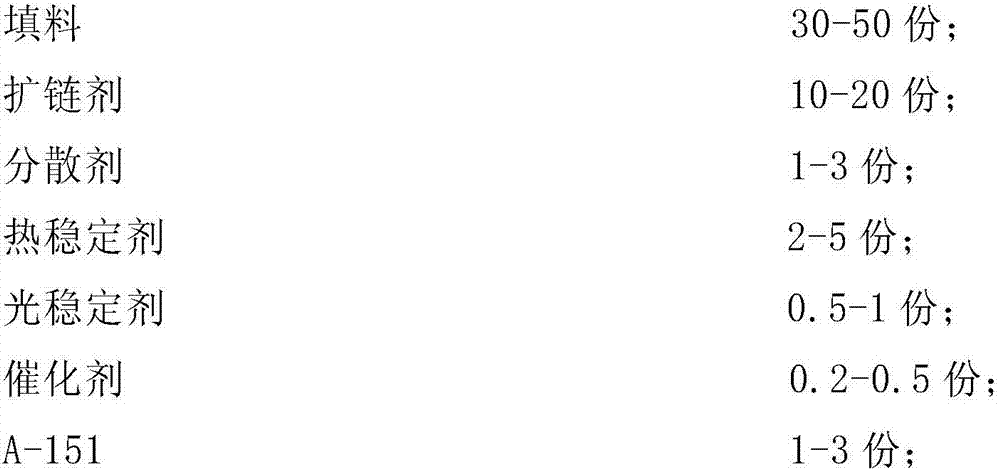Polyurethane sealant
A technology of polyurethane sealant and acetyl tributyl citrate, applied in the field of materials, can solve the problems of poor water resistance, poor weather resistance, and poor heat resistance, and achieve the effects of improving weather resistance and water resistance.
- Summary
- Abstract
- Description
- Claims
- Application Information
AI Technical Summary
Problems solved by technology
Method used
Image
Examples
Embodiment 1
[0027] Isocyanates are the basic raw materials for the preparation of polyurethanes. Among them, 1,5-naphthalene diisocyanate (NDI) has a rigid aromatic naphthalene ring structure and a relatively high melting point (127°C). The PU synthesized from it has incomparable properties of any other polyurethane elastomer, such as excellent dynamic properties, high mechanical properties, outstanding cutting resistance, wear resistance and temperature resistance, etc., and is widely used in automobile shock absorbers Devices, load-bearing wheels of forklifts, rubber rollers for printing and dyeing textiles, squeegee, buffer blocks for bridge construction, entertainment and leisure, military industry, etc.
[0028] Toluene diisocyanate (TDI) is widely used in the production of high-resilience foam. After partial trimerization of TDI, a TDI trimer solution with an isocyanurate six-membered ring structure is obtained, which has very good thermal stability. Its thermal decomposition tempe...
Embodiment 2
[0039] The formula of component A is as follows:
[0040]
[0041]
[0042] The formula of component B is as follows:
[0043]
[0044] Synthesis process of component A: add hydroxyl-terminated polybutadiene, polyether 220, and acetyl tributyl citrate into the reaction kettle, stir and heat up to 110°C, then keep warm and vacuumize for 1 hour, cool down to 70°C after the moisture is less than 0.02%, and Add TDI prepolymer and NDI prepolymer, stir and heat up to 70°C for 3 hours, cool down and pack.
[0045] Synthesis process of component B: Add 4,4′-bis-sec-butylaminodiphenylmethane and ammonium polyacrylate into the reaction kettle, heat up to 60°C, stir for 0.5h, add activated carbon in batches, heat up to 100°C and vacuumize 2h, then lower the temperature to 70°C, add dibutyltin dilaurate and the remaining additives, stir for 1h, cool down and pack.
Embodiment 3
[0047] The formula of component A is as follows:
[0048]
[0049] The formula of component B is as follows:
[0050]
[0051] 0.8 parts of 2,4-diaryl-6-[2-hydroxy-4-(piperidinyloxycarbonylmethoxy)phenyl]-1,3,5-triazine;
[0052] 0.5 parts of isopropyl titanate;
[0053] A-151 3 parts.
[0054] Synthesis process of component A: Add hydroxyl-terminated polybutadiene, polyether 220 and dibutyl phthalate into the reaction kettle, stir and heat up to 110°C, then keep warm and vacuumize for 1 hour, and cool down to 70°C after the moisture is less than 0.02%. Add TDI prepolymer and NDI prepolymer, stir and heat up to 70°C for 3 hours, cool down and pack.
[0055] Synthesis process of component B: Add dipropylene glycol and styrene-maleic anhydride copolymer into the reaction kettle, raise the temperature to 60°C, stir for 0.5h, add vermiculite in batches, heat up to 100°C and vacuumize for 2h, then cool down to 70°C, add isopropyl titanate and the remaining additives, stir...
PUM
| Property | Measurement | Unit |
|---|---|---|
| thermal decomposition temperature | aaaaa | aaaaa |
Abstract
Description
Claims
Application Information
 Login to View More
Login to View More - R&D
- Intellectual Property
- Life Sciences
- Materials
- Tech Scout
- Unparalleled Data Quality
- Higher Quality Content
- 60% Fewer Hallucinations
Browse by: Latest US Patents, China's latest patents, Technical Efficacy Thesaurus, Application Domain, Technology Topic, Popular Technical Reports.
© 2025 PatSnap. All rights reserved.Legal|Privacy policy|Modern Slavery Act Transparency Statement|Sitemap|About US| Contact US: help@patsnap.com



